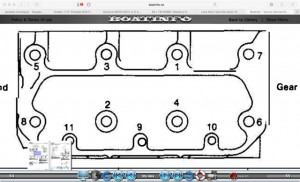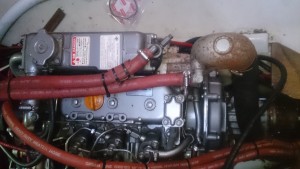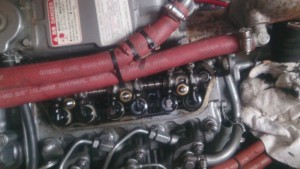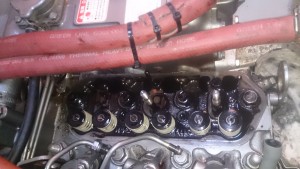The thousand hour maintenance involves changing fluids, checking and replacing the impeller, and most importantly retorquing the head.

I had been hoping that torquing the head would not involve removing the valve train. I should’ve known differently given the imperative in the manual to regap valves after torquing the head.
For anyone who hasn’t done engine work, a modern engine consists of a block that holds the pistons and the crankshaft. The crankshaft is an oddly shaped rod of heavy steel to which the pistons are attached. The pistons slide in cylinders cut into the block, when the crankshaft rotates the pistons move up and down.

Cap nuts hold the cast valve cover in place.
On top of the block, covering the top of the cylinders is the “head.” Modern designs have the valves in the head. By timing when the valves open and close, the pistons can create pressure in the cylinder. There is enough pressure in a diesel engine that the mixture of diesel fuel and air will explode merely from that pressure. This is the energy that makes the crankshaft rotate and moves the boat under power. The pressure in a diesel cylinder is something around 300 pounds per square inch.
The head must be securely and evenly bolted to the block so that there is no twisting in the head and none of the pressure can escape.

When I removed the valve cover, I discovered I would need to remove the valve train. I also needed to disconnect two of the lines feeding the fuel injection, in order to get to those bolts. As you can guess, this was when I discovered I didn’t have the tools I needed: a deep 17 mm socket, and a 17 mm open-end wrench.
I’ve found that for engine work, and other fine work where it is imperative that nuts not be rounded, and things must go well, top-notch tools, like Snap-On, make an amazing difference.
I bought one 3/8 inch drive 17 mm deep socket, and one 17 millimeter combination open-end/box wrench for a total of $23.
You can put your full weight on the 17 mm open-end wrench: the jaw will not spread, and the nut will not round.
Did the bolts move when re-torqued them? Yes, every one.
Each bolt made a click as it neared full torque, rotated a very small amount, and then reached torque.
But, and there is always a but, the number seven bolt rotated much more than made sense, more than a quarter turn. When I pushed the torque wrench the other way, counterclockwise in a loosening direction, I hit the torque number without moving the bolt. I left it that way.
Any thoughts? I did think of removing the bolt to inspect it, but I think this would have required undoing all of the bolts on the head. I had visions of the bolt stripping in the head, or stretching.
The head is not together yet as I need to buy a feeler gauge to set the valve gap. The engine is a pushrod engine.
After decades of working only with overhead cams, it was somewhat startling to hear the push rods tinkling as they fell sideways when the valvetrain was removed.

There are also tappets on top of the valve stems, which I hadn’t noticed until one stuck to the heel of my hand and lifted from the valve. I removed all six and placed them in a baggy. (Engine disassembly yields many baggies full of small parts.) Yes, every gearhead out there cringed with visions of the the tappet dropping into the engine when I said the tappet stuck to my hand.
On the rat front, the aluminum screen that I taped to the open hole was down when I returned. I don’t think the tape detached by itself.
I’ll epoxy the screen in place, then bait and set traps.
After reassembling and testing the engine and replacing the transmission oil, I’ll start replacing hoses and hose clamps. The current clamps are Home Depot-style clamps, with perforated straps. They also can be picked up by magnets; the stainless steel I’m after does not respond to magnets.
Wish me luck, and send me your comments.
